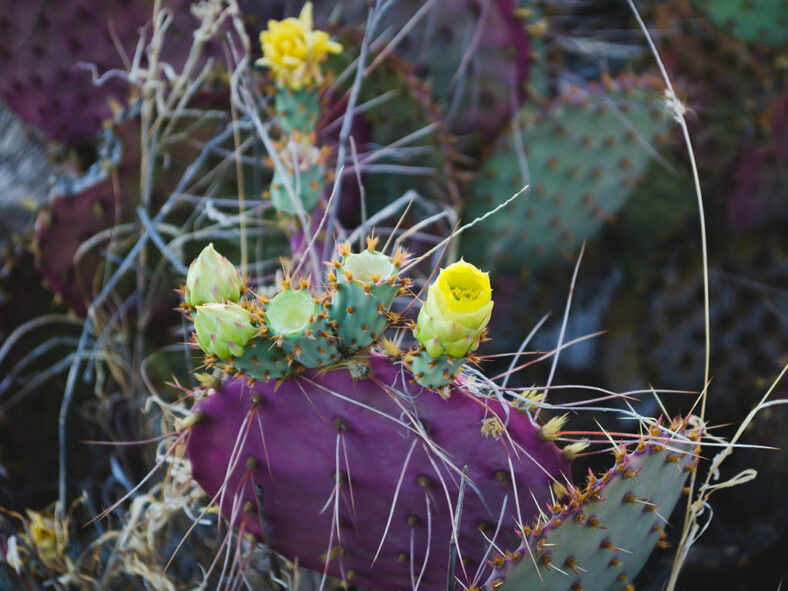Opuntia gosseliniana is a stunning ornamental cactus that adds beauty to the garden throughout the year.
Scientific Name
Opuntia gosseliniana F.A.C.Weber
Common Name(s)
Violet Pricklypear
Synonym(s)
Opuntia chlorotica var. gosseliniana, Opuntia gosseliniana var. santa-rita, Opuntia santa-rita, Opuntia violacea var. gosseliniana
Scientific Classification
Family: Cactaceae
Subfamily: Opuntioideae
Tribe: Opuntieae
Genus: Opuntia
Etymology
The specific epithet "gosseliniana" (pronounced goss-lin-ee-AN-uh) honors the French botanist Robert Roland-Gosselin (1854–1925).
Origin
Opuntia gosseliniana is native to the United States (Arizona) and Mexico (Baja California, Sonora, and Chihuahua).
Description
Opuntia gosseliniana is a shrubby or tree-like cactus with a short trunk and branches that consist of flattened, not easily detached segments. It can grow up to 3.3 feet (1 m) tall and has needle-like spines on older trunks and branches. The stem segments are subcircular and can reach a diameter of up to 8 inches (20 cm). They are gray-green to bluish-green and turn lavender to red-purple under stress. The spines can be short and stiff or long and flexible, measuring up to 4 inches (10 cm) long. They also vary in color, ranging from cream to bright yellow and through shades of orange, red, and brown to nearly black. Additionally, the areoles bear tufts of yellow to tan glochids that age to brown.
In late spring and early summer, Opuntia gosseliniana produces yellow flowers that can reach a diameter of 3 inches (7.5 cm). The fruits are purplish, elliptical to cylindrical, and contain tan seeds.

How to Grow and Care for Opuntia gosseliniana
Light: Opuntia gosseliniana thrives in full sun, but some shade during midday and afternoon can prevent sunburn in very hot climates. A window that receives sunlight 6 hours a day works best when grown indoors.
Soil: This cactus requires a soil mix that drains well. So, use a commercial cactus potting mix or create your own.
Temperature: Extremely tolerant of high temperatures, Opuntia gosseliniana prefers cooler temperatures in winter. It grows best in USDA Plant Hardiness Zones 8a to 10b, with average minimum winter temperatures ranging from 10 to 40 °F (-12.2 to 4.4 °C).
Watering: From spring to fall, water moderately and let the soil dry out completely before watering again. In most areas, rainfall will be enough for established plants. If potted, never let the container sit in water. During the winter, suspend the watering.
Fertilizing: Opuntia gosseliniana does not need fertilizer when planted in the ground. However, it will benefit from fertilizing during the growing season when grown in a container. Apply a water-soluble fertilizer. Suspend feeding during the winter when the plant goes dormant.
Repotting: Repot only when the cactus becomes potbound or is too large and unstable in its container. Choose a slightly larger container with drainage holes at the bottom. The best time for repotting is late winter or early spring.
Propagation: You can propagate Opuntia gosseliniana by stem segments or seeds. Using stem segments is the easiest method and yields faster results. For best results, take stem segments in early summer. Sow the seeds in late spring.
Learn more at How to Grow and Care for Opuntia.
Toxicity of Opuntia gosseliniana
Opuntia gosseliniana is not toxic to humans or pets. However, keep the plant away from pets and children as it has harmful spines and glochids that may cause skin irritation.
Links
- Back to genus Opuntia
- Succupedia: Browse succulents by Scientific Name, Common Name, Genus, Family, USDA Hardiness Zone, Origin, or cacti by Genus
Photo Gallery
Click on a photo to see a larger version.


